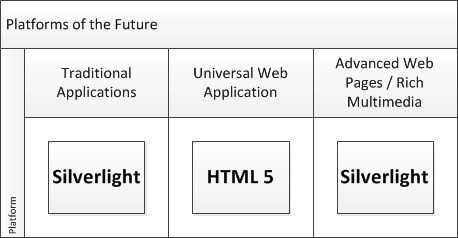Oct
24
2010
There are a lot of questions being asked about where Silveright is going, and what is it for. Microsoft has been giving pretty straight answers on the future of Silverlight but there has been a lack of quality reporting on those answers. For example, when Steve Ballmer was recently asked about HTML 5 and Silverlight his answer was that Silverlight started off as a cross-browser, cross-technology [for making websites] but that it has been repurposed as a [cross-browser, cross-technology] platform for creating client applications. This was transformed by Network World into Ballmer saying that he "sees Silverlight as useful for adding multimedia to client apps" and they also put a description on the article saying that Ballmer was commenting on the "near death of Silverlight." It is no wonder that people are confused, perfectly good and straighforward answers are being transformed into meaningless FUD by the media.
With Ballmer's actual response (which you can see at the link above), the Gu's recent video with John Papa, and the Silverlight's teams on Future of Silverlight blog post, I think the answers from Microsoft have been very clear on where Silverlight is going. However, I know there is still some confusion and people want a simple answer. So, I am going to try and condense this down to a simple graphic:

By traditional application I mean line of business applications and other applications that in the past would have written using Windows Forms or WPF. I know some of my WPF friends will take exception to this, but WPF is simply not positioned to expand from the Windows PC onto other platforms where applications are needed.
By "Universal Web Applications" I mean web sites that are supposed to reach as large of an audience as possible. This covers the vast majority of the web and includes everything from shopping sites (Amazon.com) to corporate sites (Microsoft.com)
With the last category, Advanced Web Pages and Multimedia, I am covering sites that are giving up universal reach for supporting features and capabilitites that plain HTML5 simply can't offer. Here we cover NBC's Olympic coverage, NBC's NFL Football coverage, Netflix, and anything else where just the ability to display video is not enough. I hope that we will see more tooling from Microsoft in the future to make it easier to these types of web application to a plain HTML 5 experience for platforms that do not have a Silverlight client.
Finally, let me close this out with some of my own commentary on the subject of Flash and Silverlight vs HTML 5. I think that it is important that Silverlight and Flash continue to break new ground. HTML 5 is currently adding features that Flash (and more recently Silverlight) pioneered. I think you can make a very persuasive argument that HTML 5 only exists because Flash was there first. Who knows what new abilities will be in HTML 6 that will be pioneered in current and future versions of Flash and Silverlight? The experience with the Java has taught us that innovation will not be allowed inside the standards process, at least not by Microsoft. It is better that Microsoft and Adobe have their own sandboxes outside of the "open standards" where that innovation can occur.